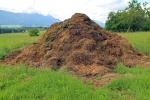PINEA Operational Group: Improvements and innovation in national pine nut production
- Type Operational group
- Status Filled
- Execution 2020 -2023
- Assigned Budget 565.999,54 €
- Scope Supraautonómico
- Autonomous community Castilla y León; Cataluña; Madrid, Comunidad de
- Main source of financing CAP 2014-2020
- Project website https://gopinea.org/
Recovering Iberian pine nut production through innovative management of the biotic and abiotic effects that are destroying it: Leptoglossus occidentalis and extreme drought.
Since 2013, a significant reduction in pine nut harvests has been detected in Spain and Portugal (which together account for 75% of the natural distribution area of the stone pine). This is already directly affecting the industry and has resulted in a marked survival crisis for processing companies, which are unable to obtain a stable supply of Iberian pine nuts, either in quantity or quality. The exceptional decline in pine nut harvests in the Iberian Peninsula over the last five years has been attributed to two main effects: repeated droughts and the attack of a recently introduced invasive insect that feeds on conifer pine cones and nuts (Leptoglossus occidentalis Heidemann). To address this situation, the PINEA Operational Group has been established.
- General:
- Restore Iberian pine nut production, and if possible increase it.
- Specific objectives:
- Knowing Leptoglossus occidentalis well, its population dynamics and the moments in which it really causes damage;
- Establish a harvest prediction system for a product that is both valued and scarce in national and international markets.
- Provide management measures that facilitate the control of the problems detected and allow for increasing/improving the product.
- Support the industrial sector, which provides direct and indirect employment to a large number of people in production areas, strengthens the population in the area, and makes the pine nut forest sustainable.
- To raise awareness of the excellence of the Iberian pine nut among the general public.
- Greater knowledge of the life cycle of Leptoglossus occidentalis. Obtaining potential pheromone precursors with semiochemicals obtained from the pest insect itself, which show clear signs of interaction and increased activity. Useful information on the behavior of different Pinus pinea clones under attack by the pest insect. Determining the climatic variables that most impact the vulnerability of stone pine stands through monitoring environmental and production variables with remote and ground-based sensors.
- Updating and developing the public version of the Pinea Climadat app and preparing the Standard Operating Procedures (SOP) Manual for Unmanned Aerial Vehicles (UAVs) for pine characterization and direct harvest assessment.
- Development of the Stone Pine Management Manual and the application protocol for the insecticide Deltamethrin 2.5% W/V for the control of Leptoglossus occidentalis in Pinus pinea plantations.
- Coordinator/entity name: CESEFOR
- Coordinator/entity email: raquel.puntero@cesefor.com | montse.ganado@cesefor.com
- Asociación Castellana de Elaboradores de Piñón (ACEP)
- Departament d’Acció Climàtica, Alimentació i Agenda Rural (Generalitat de Catalunya)
- Forestal Catalana (Generalitat de Catalunya)
- Junta de Castilla y León
- Instituto Nacional de Investigación y Tecnología Agraria y Alimentaria (INIA-CSIC)
- Universidad de Valladolid (UVA)
- Centre de Ciència i Tecnologia Forestal de Catalunya (CTFC)
- Confederación de Organizaciones de Selvicultores de España (COSE)
- Ecología y Espacio S.L. (ECOSPACIO)
- Federación de las Asociaciones Forestales de Castilla y León (FAFCYLE)
- Fundación Centro de Servicios y Promoción Forestal y de su Industria de Castilla y León (CESEFOR)
- Instituto de Investigación y Tecnología Agroalimentaria (IRTA)
- Sociedad Cooperativa Piñonsol Castilla y León (PIÑONSOL)
- Forestal de Catalunya S.C.C.L.
- Asociación Forestal de Valladolid (ASFOVA)
- Instituto de Química Avanzada de Cataluña (IQAC-CSIC)
- Universidat de Barcelona (UB)





